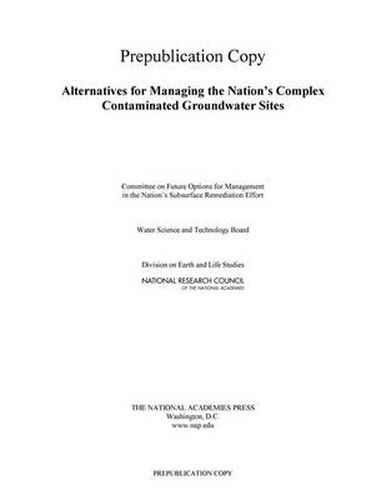Readings Newsletter
Become a Readings Member to make your shopping experience even easier.
Sign in or sign up for free!
You’re not far away from qualifying for FREE standard shipping within Australia
You’ve qualified for FREE standard shipping within Australia
The cart is loading…






Across the United States, thousands of hazardous waste sites are contaminated with chemicals that prevent the underlying groundwater from meeting drinking water standards. These include Superfund sites and other facilities that handle and dispose of hazardous waste, active and inactive dry cleaners, and leaking underground storage tanks; many are at federal facilities such as military installations. While many sites have been closed over the past 30 years through cleanup programs run by the U.S. Department of Defense, the U.S. EPA, and other state and federal agencies, the remaining caseload is much more difficult to address because the nature of the contamination and subsurface conditions make it difficult to achieve drinking water standards in the affected groundwater.
Alternatives for Managing the Nation’s Complex Contaminated Groundwater Sites estimates that at least 126,000 sites across the U.S. still have contaminated groundwater, and their closure is expected to cost at least $110 billion to $127 billion. About 10 percent of these sites are considered complex, meaning restoration is unlikely to be achieved in the next 50 to 100 years due to technological limitations. At sites where contaminant concentrations have plateaued at levels above cleanup goals despite active efforts, the report recommends evaluating whether the sites should transition to long-term management, where risks would be monitored and harmful exposures prevented, but at reduced costs.
$9.00 standard shipping within Australia
FREE standard shipping within Australia for orders over $100.00
Express & International shipping calculated at checkout
Across the United States, thousands of hazardous waste sites are contaminated with chemicals that prevent the underlying groundwater from meeting drinking water standards. These include Superfund sites and other facilities that handle and dispose of hazardous waste, active and inactive dry cleaners, and leaking underground storage tanks; many are at federal facilities such as military installations. While many sites have been closed over the past 30 years through cleanup programs run by the U.S. Department of Defense, the U.S. EPA, and other state and federal agencies, the remaining caseload is much more difficult to address because the nature of the contamination and subsurface conditions make it difficult to achieve drinking water standards in the affected groundwater.
Alternatives for Managing the Nation’s Complex Contaminated Groundwater Sites estimates that at least 126,000 sites across the U.S. still have contaminated groundwater, and their closure is expected to cost at least $110 billion to $127 billion. About 10 percent of these sites are considered complex, meaning restoration is unlikely to be achieved in the next 50 to 100 years due to technological limitations. At sites where contaminant concentrations have plateaued at levels above cleanup goals despite active efforts, the report recommends evaluating whether the sites should transition to long-term management, where risks would be monitored and harmful exposures prevented, but at reduced costs.